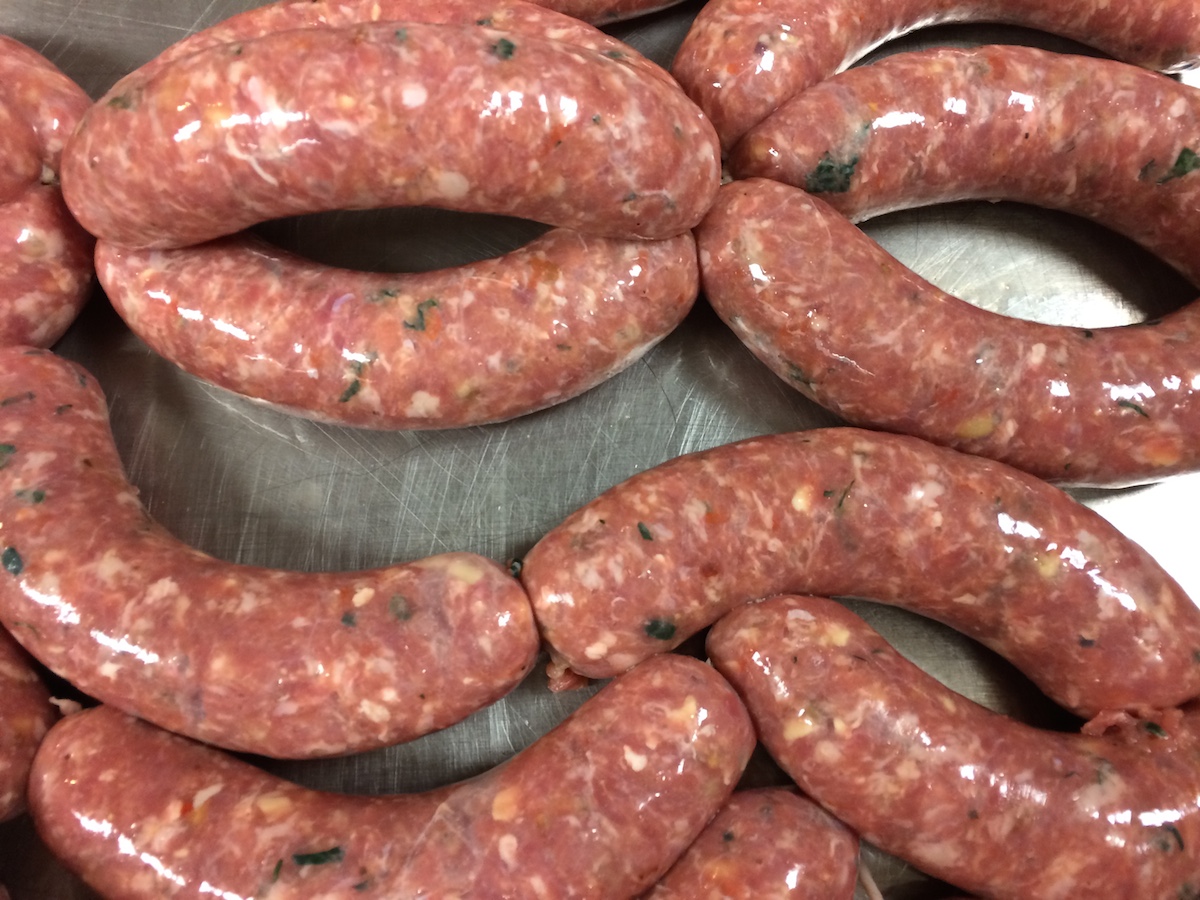The Local newsletter is your free, daily guide to life in Colorado. For locals, by locals.
Growing up in the Dakotas, where ranches and farms dominate the social and economic landscape, meat played a part in every meal. When times were good, we ate steaks. When they weren’t, it was meatloaf. Extended families gathered together for massive butchering days, cutting up a farm pig or a young steer that had fattened up on prairie grasses. Everyone would pitch in, including kids who’d turn the crank to push out sausage by the foot. Depending on your ancestry, you’d make German sausage, Polish sausage, country-style sausage, breakfast sausage, blood sausage, and so on.
If you wanted to start a family feud, you’d simply suggest using more garlic than Grandma’s original recipe called for. Looking through an old family cookbook recently, I found multiple recipes—from different branches of the same family tree—for country-style sausage that differed only in miniscule amounts of garlic or ground pepper. Of course, all variations had to be printed because heirloom-style sausage is serious business. In my family, sausage is not just a style of meat preparation: it’s basically a food group.

Although I’ve found plenty of local sausage purveyors to feed my cravings (Sawa Sausage, Tony’s Market, Western Daughters Butcher Shoppe), I still craved the German-inspired links of my youth. These are harder to come by now, as families have shrunk and scattered. I did find a butcher in my hometown where I could pick up a dozen or so pounds of Dakota-style sausage when I returned north each year. (I even own a special cooler just for this purpose.)
But that butcher recently closed after 26 years of business, which left me in a predicament. I could start calling members of my extended family and beg for sausage—or I could learn to do it myself in my urban kitchen. I had just started spending an inordinate amount of time looking at meat grinders and sausage stuffers on Amazon.com, when I heard that Western Daughters offered a Sausage 101 class for $75. I immediately picked up the phone to sign up.
The intimate class—with just four students—began with mixing an apple-whiskey sausage (ground pork, apple, Leopold Bros. New York Apple Whiskey, mustard seeds, pepper, sea salt, and ground mustard). Our instructor, chef Brian Casey, explained that the meat was ground twice to evenly distribute the fat but not over process the pork.
While mixing in the ingredients, he cooked samples on the stove twice so that we could taste how the flavors developed once cooked—a not-to-be skipped step in sausage making. He explained how we’d use hog casings (yes, casings are intestines) for bratwurst-sized links, but you could use lamb casings to make tiny breakfast sausages.
Referring to the flavor profiles we’d just sampled, Casey asked us what type of sausage we wanted to make next. We quickly agreed upon a Mediterranean-inspired concept, but were stumped on where to start. Casey started pulling ingredients off the shelves and out of the fridge. What about toasted pine nuts? Some white wine? We could chiffonade some kale and add in some feta or Provolone, sound good? My classmates and I nodded in agreement. The resulting blend had a massive list of ingredients with bold flavors—pork, kale, red onion, crushed red pepper, oven-roasted tomatoes, provolone, garlic, pickled white onions, toasted pine nuts, white wine, fennel seeds, black pepper, sea salt—which all melded subtlety when cooked.
Next, Casey showed us how to slide the casings onto the sausage stuffer, fill the contraption, and urgently (not too fast or too slow) crank the sausage out in a long coil without “blowing out” (overstuffing until the casing breaks). Next, he used a sausage knife to “aerate” the links by poking holes every few inches on the coil. Finally, he grasped about five inches of sausage and swung it like a jump rope until the link had turned at least three times to create a knot, before moving on to the next segment.
As Casey worked to fill, turn, and braid the links that we’d all take home, we continued brainstorming. Could we use sumac in a lamb sausage? What about a link inspired by Indian cuisine? Could we do a no-salt version for special diets? And so on. By the time Casey handed us our butcher-paper-wrapped packages of links, I had a dozen ideas for how to make my own sausage at home. I had mentally moved that KitchenAid meat grinder attachment from my “Wish List” to “Cart” on Amazon.com. And, most importantly, I had plans to tackle one of those country-style sausage recipes that I had grown up with.
Want to Try? Western Daughters’ Sausage 101 classes are scheduled for May 13, June 24, and July 29 (5:30–7 p.m.). Sign up by calling 303-477-6328.
Follow senior editor Natasha Gardner on Twitter, Instagram, or Pinterest.








